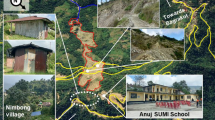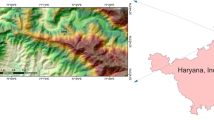Abstract
The Pawari landslide zone, located in the Satluj valley, Himachal Pradesh (India), is a progressive complex landslide zone that is ~ 900 m long and ~ 4000 m wide and encompasses an area of ~ 6 km2. It is observed that the frequency of the slope failure in the landslide zone and dimension of the landslide area have increased considerably in the last decade that pose threat to the human population of about 6000 residing in the vicinity of the landslide zone. The finite element method (FEM) and kinematic analysis are used for stability analyses, while high-resolution imagery, slope failure data and rain-gauge-based rainfall data are used to infer landslide activity. The FEM analysis involved numerical simulation of two slope models, i.e. S-1 (rockmass only) and S-2 (rockmass overlain by debris) that were chosen along the width of the landslide zone. The shear strength reduction method was incorporated in FEM to quantify the existing slope strength and to infer pattern of strain and displacement. The analyses results show that the main scarp of the landslide zone has increased ~ 7% between 2005 and 2014, and presently, major as well as minor scarps accommodate maximum shear strain (0.001–0.006) and displacement (0.08–0.20 m). The kinematic analysis reveals wedge failure in the rockmass that corroborates with the field evidences of rock failure. The present work intends to evaluate the hazard of landslide zone by analysing landslide activity pattern and determining shear strain and displacement of the slope.











Similar content being viewed by others
References
Barton NR (1974) A review of the shear strength of filled discontinuities in rock. Norw Geotech Inst Publ 105:38
Bhasin R, Kaynia AM (2004) Static and dynamic simulation of a 700-m high rock slope in western Norway. Eng Geol 71(3):213–226
Borrelli L, Antronico A, Gullà G, Sorriso-Valvo GM (2014) Geology, geomorphology and dynamics of the 15 February 2010 Maierato landslide (Calabria, Italy). Geomorphology 208:50–73
Bowles JE (1996) Foundation analysis and design, 5th edn. McGraw-Hill, New York, p 750
Burchfiel BC, Zhiliang C, Hodges KV, Yuping L, Royden LH, Changrong D, Jiene X (1992) The South Tibetan detachment system, Himalayan orogen: extension contemporaneous with and parallel to shortening in a collisional mountain belt. Geol Soc Am Spec Pap 269:1–41
Cai M, Kaiser PK, Uno H, Tasaka Y, Minami M (2004) Estimation of rock mass deformation modulus and strength of jointed hard rock masses using the GSI system. Int J Rock Mech Min Sci 41(1):3–19
Cai M, Kaiser PK, Tasaka Y, Minami M (2007) Determination of residual strength parameters of jointed rock masses using the GSI system. Int J Rock Mech Min Sci 44(2):247–265
Census of India (2011) District Census Handbook; Kinnaur. Directorate of Census Operations, Himachal Pradesh
Crowder JJ, Bawden WF (2004) Review of post-peak parameters and behaviour of rock masses: current trends and research. Rocnews, 13
Cruden DM, Varnes DJ (1996) Landslides: investigation and mitigation. Chapter 3-Landslide types and processes. Transportation Research Board Special Report (247)
Diederichs MS, Carvalho JL, Carter TG (2007) A modified approach for prediction of strength and post yield behaviour for high GSI rockmasses in strong, brittle ground. First Canada-US Rock Mechanics Symposium, Vancouver, pp 249–257
Dimri AP, Niyogi D, Barros AP, Ridley J, Mohanty UC, Yasunari T, Sikka DR (2015) Western disturbances: a review. Rev Geophys 53(2):225–246
Fisher GB, Amos CB, Bookhagen B, Burbank DW, Godard V (2012) Channel widths, landslides, faults, and beyond: the new world order of high-spatial resolution Google Earth imagery in the study of earth surface processes. Geol Soc Am Spec Pap 492:1–22
Fredlund DG, Krahn J (1977) Comparison of slope stability methods of analysis. Can Geotech J 14(3):429–439
Geological Survey of India, Ministry of Mines, Government of India, www.gsi.gov.in, retrieved on 02nd March 2016
Griffiths DV, Lane PA (1999) Slope stability analysis by finite elements. Geotechnique 49(3):387–403
Gupta V (2005) Application of lichenometry to slided material in the Higher Himalaya landslide zone. Curr Sci 89(6):1032–1036
Gupta V, Sah MP (2008) Spatial Variability of Mass Movements in the Satluj Valley, Himachal Pradesh during 1990–2006. J Mt Sci 5:38–51
Gupta V, Bhasin RK, Kaynia AM, Kumar V, Saini AS, Tandon RS, Pabst T (2016a) Finite element analysis of failed slope by shear strength reduction technique: a case study for Surabhi Resort Landslide, Mussoorie Township, Garhwal Himalaya. Geomat Nat Hazard Risk 7(5):1677–1690
Gupta V, Nautiyal H, Kumar V, Jamir I, Tandon RS (2016b) Landslides hazards around Uttarkashi township, Garhwal Himalaya, after the tragic flash flood in June 2013. Nat Hazards 80:1689–1707
Gupta V, Jamir I, Kumar V, Devi M (2017) Geomechanical characterisation of slopes for assessing rockfall hazards in the Upper Yamuna Valley, Northwest Higher Himalaya, India. Himal Geol 38(2):156–170
Guzzetti F, Carrara A, Cardinali M, Reichenbach P (1999) Landslide hazard evaluation: a review of current techniques and their application in a multi-scale study, Central Italy. Geomorphology 31(1):181–216
Guzzetti F, Mondini AC, Cardinali M, Fiorucci F, Santangelo M, Chang KT (2012) Landslide inventory maps: new tools for an old problem. Earth Sci Rev 112(1):42–66
Hoek E (1994) Strength of rock and rock masses. ISRM News J 2(2):4–16
Hoek E, Bray JW (1981) Rock slope engineering, revised, 3rd edn. London, Taylor and Francis
Hoek E, Brown ET (1997) Practical estimates of rock mass strength. Int J Rock Mech Min Sci 34(8):1165–1186
IS: 2720, Part 4 (1985) Methods of test for soils: Grain size analysis. In: Bureau of Indian Standards, New Delhi, India
IS: 2720, Part 13 (1986) Method of test for soils: direct shear test. In: Bureau of Indian Standards, New Delhi, India
IS: 2720, Part 10 (1991) Method of test for soils: determination of unconfined compressive strength. In: Bureau of Indian Standards, Delhi, India
IS: 9143 (1979) Method for the determination of unconfined compressive strength of rock materials. In: Bureau of Indian Standards, New Delhi, India
Jamir I, Gupta V, Kumar V, Thong GT (2017) Evaluation of potential surface instability using finite element method in Kharsali Village, Yamuna Valley, Northwest Himalaya. J Mt Sci 14(8):1666–1676
Jing L (2003) A review of techniques, advance and outstanding issues in numerical modelling for rock mechanics and rock engineering. Int J Rock Mech Miner Sci 40:283–353
Kanungo DP, Pain A, Sharma S (2013) Finite element modeling approach to assess the stability of debris and rock slopes: a case study from the Indian Himalayas. Nat Hazards 69(1):1–24
Kawagoe S, Kazama S, Sarukkalige PR (2009) Assessment of snowmelt triggered landslide hazard and risk in Japan. Cold Reg Sci Technol 58(3):120–129
Kirschbaum D, Adler R, Adler D, Peters-Lidard C, Huffman G (2012) Global distribution of extreme precipitation and high-impact landslides in 2010 relative to previous years. J Hydrometeorol 13(5):1536–1551
Kumar V, Gupta V, Sundriyal YP (2018) Spatial interrelationship of landslides, litho-tectonic and climate regime, Satluj valley, Northwest Himalaya. Geol J. https://doi.org/10.1002/gj.3204
Landslide Mapping and Vulnerability Assessment, Indian Meteorological Department, Ministry of Earth Science, Govt. of India, www.imd.gov.in, retrieved 20th Jan 2016
Martha TR, Roy P, Govindharaj KB, Kumar KV, Diwakar PG, Dadhwal VK (2015) Landslides triggered by the June 2013 extreme rainfall event in parts of Uttarakhand state, India. Landslides 12(1):135–146
Mathew J, Babu DG, Kundu S, Kumar KV, Pant CC (2014) Integrating intensity–duration-based rainfall threshold and antecedent rainfall-based probability estimate towards generating early warning for rainfall-induced landslides in parts of the Garhwal Himalaya, India. Landslides 11(4):575–588
Matsui T, San KC (1992) Finite element slope stability analysis by shear strength reduction technique. Soils Found 32(1):59–70
Nian TK, Chen GQ, Wan SS, Luan MT (2011) Non-convergence criterion on slope stability FE analysis by strength reduction method. J Converg Inf Technol 6:78–88
Rahardjo H, Lee TT, Leong EC, Rezaur R (2005) Response of a residual soil slope to rainfall. Can Geotech J 42(2):340–351
Ribacchi R (2000) Mechanical tests on pervasively jointed rock material: insight into rock mass behaviour. Rock Mech Rock Eng 33(4):243–266
Roscoe KH (1970) The influence of strains in soil mechanics, Tenth Rankine Lecture. Geotechnique 20:129–170
Sah MP, Mazari RK (1998) Anthropogenically accelerated mass movement, Kulu Valley, Himachal Pradesh, India. Geomorphology 26(1):123–138
Sato PH, Harp EL (2009) Interpretation of earthquake induced landslides triggered by the 12 May 2008 M7.9 Wenchuan earthquake in the Beichuan area, Sichuan Province, China using satellite imagery and Google Earth. Landslides 6:153–159
Sharma KK (1977) A contribution to the geology of Satluj Valley, Kinnaur, Himachal Pradesh, India. Collques Int du CNRS 268:369–378
Sharma S, Chand G (1981) A geological report on Telangi landslide district Kinnaur, Himachal Pradesh. GSI Special Publ 6:109–118
Shroder JF (1998) Slope failure and denudation in the western Himalaya. Geomorphology 26(1):81–105
Singh TN, Verma AK, Sarkar K (2010) Static and dynamic analysis of a landslide. Geomat Nat Hazards Risk 1(4):323–338
Srikantia SV, Bhargava ON (1998) Geology of Himachal Pradesh. Geological Society of India, Bangalore
Valdiya KS (1973) Lithological sub-divisions and tectonics of the Central Crystalline Zone of Kumaon Himalaya. In: Proceedings of symposium on geodynamics of the Himalayan region: Hyderabad, India. National Geophysical Research Institute, pp 204–205
Vannay JC, Grasemann B (2001) Himalayan inverted metamorphism and syn-convergence extension as a consequence of a general shear extrusion. Geol Mag 138(03):253–276
Volkwein A, Schellenberg K, Labiouse V, Agliardi F, Berger F, Bourrier F, Dorren LK, Gerber W, Jaboyedoff M (2011) Rockfall characterisation and structural protection-a review. Nat Hazards Earth Syst Sci 11:2617–2651
Whitmeyer SJ, Bailey JE, De Paor DG and Ornduff T (2012) Google earth and virtual visualizations in geoscience education and research. Special Paper 492, Geological Society of America, USA
Yadav OP (2000) An evaluation report on investigation, instrumentation and monitoring of landslides in Himachal Pradesh. Department of Science and Technology, New Delhi
Yang W, Lingling S, Peijun S (2015) Mapping landslide risk of the world. In: Shi P, Kasperson R (eds) World atlas of natural disaster risk. Springer, Berlin, pp 57–66
Zheng H, Liu DF, Li C (2005) Slope stability analysis based on elasto-plastic finite element method. Int J Numer Methods Eng 64(14):1871–1888
Acknowledgements
The Authors are thankful to the Director, Wadia Institute of Himalayan Geology (WIHG), Dehradun for all the necessary facilities to carry out the work. The soil and rock testings were carried out in Geotechnical laboratory of the WIHG and National Geotechnical Facility (NGF), Dehradun. The authors are also thankful to the Reckong Peo District administration and BRO (Pawari) for the help rendered during the field work. Authors acknowledge the Editor in Chief, Dr. Thomas Glade and anonymous reviewers for their constructive comments that helped to improve the manuscript. The study forms a part of doctoral (Ph.D.) work of Vipin Kumar.
Author information
Authors and Affiliations
Corresponding author
Rights and permissions
About this article
Cite this article
Kumar, V., Gupta, V. & Jamir, I. Hazard evaluation of progressive Pawari landslide zone, Satluj valley, Himachal Pradesh, India. Nat Hazards 93, 1029–1047 (2018). https://doi.org/10.1007/s11069-018-3339-3
Received:
Accepted:
Published:
Issue Date:
DOI: https://doi.org/10.1007/s11069-018-3339-3




